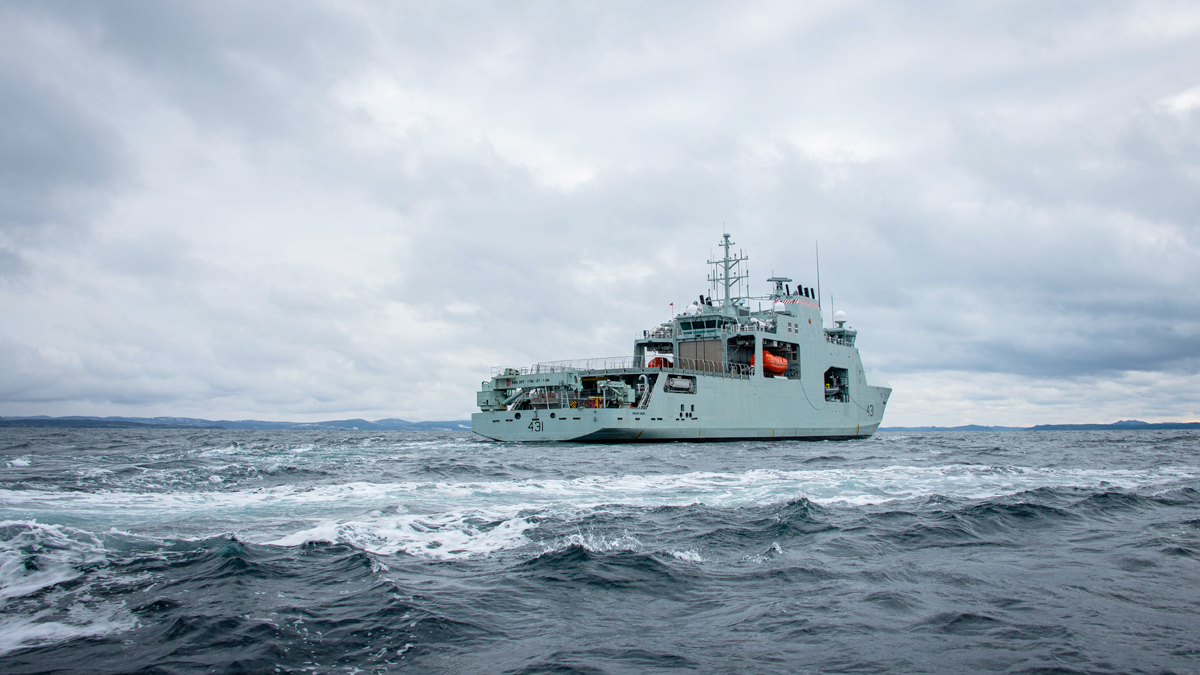Margaret Brooke crew praise new platform ahead of ice trials
By Lookout Production on Mar 01, 2022 with Comments 0

HMCS Margaret Brooke facilitates a boat transfer in Conception Bay Harbour during their transit to the Arctic for ice trials on Feb. 20. Photo by S2 Taylor Congdon, Canadian Armed Forces Photo
Joanie Veitch
Trident Newspaper
—
As the future HMCS Margaret Brooke, Canada’s second Arctic and Offshore Patrol Ship (AOPS), left Halifax on Feb. 17, the crew was full of anticipation. Not only were they heading off to do cold weather and ice trials, this marked the first time they would spend an extended period out at sea with their new ship.
Bound first for Newfoundland before heading north to the Labrador Sea, Margaret Brooke will move through the Davis Strait into Baffin Bay, looking for temperatures of 30-below Celsius or colder and metre-thick ice to run through a series of trials mean to test the ship’s capabilities.
It’s expected to be about a four-week trip, although flexibility with the schedule is key, says Lt(N) Graham Austin, Navigating Officer. “You can have a set schedule but because we need specific conditions we need to have maximum flexibility built in.”
Like others in the Harry DeWolf-class of vessels, Margaret Brooke is a different ship from most in the Royal Canadian Navy, not only from an operational perspective, but also in terms of the quality of life for the crew, as their home-away-from-home for long periods of time.
“I’ve sailed on frigates, MCDVs (Maritime Coastal Defence Vessels) and now on the AOPV (Arctic Offshore Patrol Vessels). I’ve had lots of at-sea time, just a little over 1,300 days, so I can speak to the creature comforts of the AOPV platform,” says PO1 Ron Kennedy, Naval Communicator. “The AOPV, the best way to explain it is that it’s like being on a cruise ship as compared to a frigate or MCDV.”
So what is it about these ships that make them so different from the rest of the fleet?
“It’s spacious,” says Lt(N) Austin. “The ship is a patrol ship, not at all a combatant like the frigates. It’s built to navigate in ice so it needs to be of a sufficient size to be able to break the ice and sail in those kinds of conditions. Everything on board is just a little bit bigger and because we’re a smaller crew, comparatively speaking, there’s just a lot more room for everyone.”
At present, Margaret Brooke has a crew of 68. By comparison, the Halifax-class frigates operate with a crew of 230-plus, and the MCDVs – a much smaller ship than the AOPV – has a crew of about 48.
The new ships offer more space in the crew accommodations, more toilets or “heads” and wash spaces, an all-ranks cafeteria, better digital connectivity, and a dedicated fitness space with gym equipment.
The ship’s traditional messes are socialization areas only, and the main eating area is an all-ranks cafeteria, explains Lt(N) Jennifer Grant, Bridge Watchkeeper and the ship’s Information Management Officer.
The cafeteria is well laid out, featuring a serving buffet and salad bar, and even a cappuccino machine. The addition of portholes adds natural light, a huge plus when spending a long time at sea.
“It’s much more inclusive as everyone is together,” says Lt(N) Grant.
The addition of a dedicated workout space is another plus with the new ships. In Margaret Brooke, space allows for up to eight members using the gym area at a time, and more in the hangar when there’s no embarked helicopter on board.
“We’ve outfitted the gym space with extra equipment and turned the hangar into a crossfit area,” says PO1 Kennedy, who also acts as the sports coordinator on board. “Having that space makes a huge difference to quality of life. For me, quality of life starts with fitness.”
Advanced technology and the ability to use more automation are other improvements that bring big benefits as well, says Lt(N) Matthew Parnell, Assistant Naval Technical Officer.
“We have personnel monitoring and responding to do regular maintenance accordingly, but we’re a smaller crew and having that automation frees us up a lot,” he says. “Everything on these ships is just a lot more comfortable.”
Filed Under: Top Stories
About the Author:





